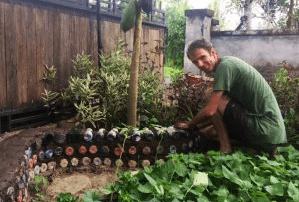Last week, I was in Singapore to visit a grand tree in the jungle.
Singapore is known for its modern urban experiences. But last week for four nights, giant lizards, turtles and bees were my neighbours while I camped near a giant Banyan tree in a dense forest on the island. What was meant to have been a trip to renew my passport morphed into a solemn and sad, sacred and surreal, reconnection with the wild.
When it became clear I wasn’t going to be able to renew my passport because of a forgotten ID, I extended my stay under the tree, so that I could participate in Remembrance Day for Lost Species event on November 29th. Several of my Singaporean friends have been attending eco-film festivals, where they have been saddened by movie after movie documenting animal tragedies. Lamenting, they had prepared over two weeks, a ceremony to mark this international day.
Residing in the jungle, contemplating the tree and my varied animal neighbours, the day gained a whole new depth of meaning.
More species are going instinct than ever before. We live in a time that has been dubbed the ‘Sixth Extinction’, (check out the book by that name) that is right up there with the meteor that wiped out the dinosaurs… Right now — as in right this moment — species that have been around for ages (literally Ages), are disappearing though over-hunting, habitat loss, and habitat change. Apparently, the rate of species loss is higher than it has been in hundreds of millions of years.
I chose to set my tent up in the jungle because of a singular Banyan tree that I some friends introduced me to a few months ago on the forested outskirts of the Ground Up-Initiative. GUI is an attempt by a collective of Singaporeans to maintain some gardens, forest and facilities for folks to reconnect with the land. The Banyan itself is one of the most amazing trees that I have ever met. The tree itself is over 40 meters in diameter. No typo: 40 meters! Its root mass spreads out in a mighty mandala of tubular rhizomes. Its central core is roughly 10 meters in diameter. This core however, is not a solid tree trunk, rather a loose half-moon cluster of dozens of sturdy, pipe-like trunks. An unlike other Banyan trees, it is not a densely packed core; there are several meters between each trunk. The tree is thus imminently climbable! One can go wayyy up, or just climb around horizontally in every direction on the thick, interlaced, vertical and horizontal trunks.
The cluster itself is resting on an intricate mesh of tiny roots that actually guide a stream into itself. The mesh, like a giant spongy mass of noodles, is so dense and intricate that I couldn’t help think of it as some sort of central neural mass at the heart of the tree. Indeed, with its lofty span, it holds presence, sensing and aware of everything happening above and below.
Alas, this amazing entity’s days are surely numbered.
The city encroaches on all sides.
It’s living its last chapter– its story a parallels of so many extinct and soon to be extinct species.
Almost no one I met, even the staff and long-term volunteers on the property where I was staying knew about the tree. It is tucked into an obscure corner of property on government land that is managed by no one. On one side is a massive 40 million dollar development. Cranes and tractors and trucks of all kinds work away unseen 20 meters over a high concrete barrier. And on the other side maybe 50 meters away another crane and construction site. From the branches of the tree you can see the MRT swish past.
One day, some nameless worker on a bulldozer, tired from too many shifts, will bring the tree down in a crunch of wood. No one will notice as its existence is snuffed out– like a candle in a midnight cathedral… flickering in rush of air… and… darkness. A silent end to a grand entity. Just as the ancient million-year genetic lineages of the dodo, Steller’s sea cow, the Western black rhinoceros, Passenger pigeon, the quagga, and countless known and unknown contemporary species are silently disappearing.
“Here, in the fall, large flocks of pigeons fly,
So numerous, that they darken all the sky”
– Thomas Makin, Pennsylvania, on the estimated billions of Passenger Pigeons that still populated North America in 1729.
The ritual my friends held was sombre and joyful. We were happy to see old friends, yet sad and solemn as we rested our thoughts on the great tragedy of our age. The mindfully crafted ceremony was an acknowledgement of something unspoken, something that we have all privately lamented. To do so collectively, together, finally, was helpful, dare I say… invigorating.
The process empowered us to ponder and realize our place in it all. We aren’t so different after all, from the guy on the bulldozer; trying to make ends meet, make his pay-check, just doing his job, part in the system, taking down some bush to make way for growth and progress.
My friend, Mel, who lead the ceremony, observed wisely the real tragedy of course is not that this tree, that these species, are ending. Everything, everywhere, and every time comes to its end. The real tragedy is that the driving force behind the carnage is our unconsciousness of their majesty, their connection to us and to others.
The urge and drive for survival, for individuals and a species, is one of the most powerful creative drives on the planet. What if our drive for survival included the awareness that we couldn’t live without everyone else?


